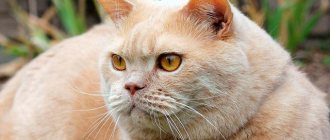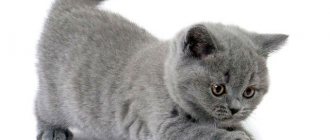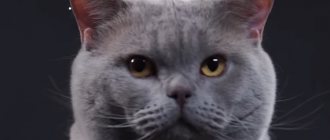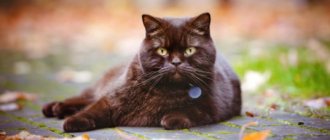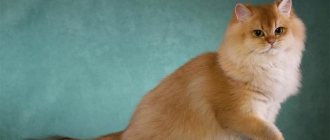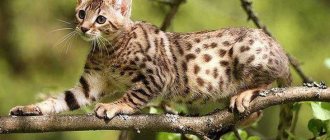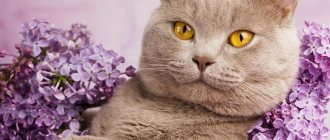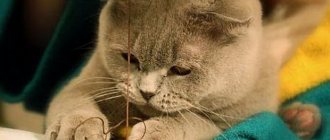Review author: “ZooVita”
The main distinguishing feature of this cat breed, from which it got its name, is its short hair, the appearance of which can be seen in the photo of a British Shorthair cat. There is no exact information about the homeland of this beautiful cat.
According to some sources, she appeared in France, while other sources claim that she is a descendant of Egyptian cats. The first exhibition at which this breed was presented took place in England in 1871.
After this exhibition, breeders and cat lovers paid attention to the British Shorthair, being impressed by the beauty of its dense coat.
The cat gained worldwide fame and distribution only in the 20th century, and was brought to the Russian Federation in 1980. Currently, the breed is popular all over the world.
Appearance of the British Shorthair cat
The description of the British Shorthair cat can begin with the fact that despite its rather large size, it has truly feline grace and elegance. This breed attracts with its beautiful, deep look and velvety coat, which is very pleasant to the touch and appearance.
If necessary, the British Shorthair can be a good hunter. The weight of representatives of the breed can range from four to eight kilograms.
He has fairly broad shoulders, a chest and a powerful body. The round and wide head has a short nose. The eyes are also round, the color of which depends on the type of breed and can be orange, blue or green.
The paws are small, but massive with thick claws. The tail has a rounded end, thickened at the base. The ears of British Shorthairs should be straight and erect, this indicates the purebred of the individual. The coat has a dense undercoat and is short and dense.
British newborns, what they look like, photos
Outdoor cats choose dark, warm places to give birth, usually basements and attics. At home, you need to provide a “birther” for the British woman. It can be made from a large box, 60x60 cm in size, 40 - 50 cm high. Store banana boxes and exhibition tents are suitable. Lay out a diaper for animals and a heating pad.
Depending on the number of kittens in the cat’s womb, a newborn kitten can have a body length of 8 - 12 cm, the weight of kittens is from 70 - 120 g, there are small ones of 50 - 60 g, this happens when there is a multiple pregnancy. Weight table here.
The British are born blind, deaf, with large claws, without undercoat, the fur is not able to warm the baby, so you need to monitor the temperature of the “birthing place” ≈ 38 - 39 C⁰. At the age when kittens sleep 95% of the time, their innate sense of smell and touch allows them to find the cat's nursing nipple. The British mother licks the kittens; without her, they are unable to defecate. In the period from birth to 2 - 3 weeks, you should monitor the daily weight gain of babies by 10 - 20 grams, they should be weighed in the morning at the same time. If someone does not finish eating, then put it on the nipple more often.
Photo – British kittens 3 days old
Stages of development of a newborn British baby by day:
- Days 1 – 3 – baby sleeps, eats; how to determine the sex of newborn kittens is described in detail here
- 3 – 6 days – the umbilical cord heals, becomes black, dries out, and falls off;
6 days per photo
the picture shows that some already have an umbilical cord missing
- 4 – 7 days – hearing is formed, there is a reaction to loud sounds. The British are all straight-eared!
Plush kittens at 1 week
During this period, babies begin to crawl more actively, and many begin to open their eyes. Children's undercoat is formed and they react more actively to sounds.
British 7 days | 1 Week
It's time to increase the area for cats and choose a name.
British kittens in a playpen
Video of the British in 10 days below.
Little kitties 2 weeks old
British Shorthairs grow quickly, their weight has tripled since birth. They began to sleep less, eat less often, but the portions became larger. They begin to walk unsteadily, with long claws allowing them to maintain balance. By the end of the second week, the eyes open, they will immediately be a little cloudy. The first eye color is blue. They are seen a couple of days after opening on days 14–17. They hear the cat better and respond to its purring.
2 weeks
14 days
British 3 weeks
Kitties see and hear everything, sit and walk confidently, and try to jump. Baby teeth are visible. They are very curious and try to get out of their beds, so it is worth using fences and playpens. The area for children to play should be increased. Provide a scratching post, soft toys, a tray with filler and water.
The cubs actively play with each other, bite and hiss, and practice hunting skills.
2.5 weeks
3 weeks
Types of colors of the British Shorthair cat
The most common color is blue. But the colors of the British Shorthair cat are very diverse:
Solid color
The cat's fur, like its skin, should be the same color. The most widely represented color is blue, but other options are possible: black, lilac, chocolate, red and white. The rarest solid colors of the British Shorthair cat are: cinnamon and fawn.
The black color combines surprisingly beautifully with yellow eyes. The lilac color is artificially bred. The value of a chocolate-colored cat becomes higher depending on the intensity of its shade.
In short-haired dogs with a red color, the intense color is considered valuable. The White British Shorthair cat is very difficult to breed and has a high risk of giving birth to offspring with defects.
The rarest color of the cat's color - "Cinnamon" - is very much appreciated by lovers of the breed. But the rarest of the colors is considered to be “Faun”. This color is valuable because it makes it possible, during breeding, to produce offspring of new light shades.
Tortoiseshell color
Basically, females are endowed with this complex and beautiful color, while males, if they have a tortoiseshell color, are sterile. Particularly appreciated is the presence of red or cream shades on the cat’s face in this color.
Silver and golden color
Cats with such a magnificent color are also called British chinchillas. The British species with this coloring is one of the rare and most expensive.
Eye color typical for silver cats: blue, lilac or green. Individuals with a golden color are considered defective if there is a gray undercoat.
Color Point
The similarity of the British Shorthair Color Point with cats of the Siamese breed is due to the characteristic coat colors: basic white in combination with black, chocolate or red.
Tabby
An amazing feature of the British Tabby color is the presence of patterns on the coat in the form of symmetrical stripes and spots on any non-primary color. Tabby cats are very similar to tigers or leopards.
"Whiskas"
A valuable type of color, characterized by clear stripes covering the entire body of the cat, is the Whiskas color. The pattern should be as clear and contrasting as possible.
Bicolor or "Harlequin"
The peculiarity of the color is the presence of two colors, the predominant of which is white. The additional color may not be uniform and may have patterns.
Hereditary diseases: what you need to know about British health
The incredible popularity of the breed led to sad consequences. People simply bred their British cats with anyone, knowing that there would still be a queue for the kittens. It’s easy to sell such “British” dogs without documents, but 5 times cheaper than from the breeder. And buyers are happy - after all, they don’t want a cat for exhibition, but for the soul.
British kitten, silver tabby color
As a result, the British were bred with the Scots, animals with obvious defects such as too flat a nose were allowed to breed, and producers who brought kittens with congenital diseases were not culled. All this has led to the fact that the once healthy cat breed is considered one of the most problematic among veterinarians. “What did you want, you have a Briton,” - this phrase can easily be heard in a veterinary clinic. Before you run for a kitten “from an advertisement” or look for a mate for your “sort of British” cat, you need to study information about these diseases:
- Blood type incompatibility.
Like humans, cats have different blood types: A, B and AB (the latter is very rare). The blood type greatly depends on the breed of the pet. For example, all Siamese have blood type A. British cats have a problem: part of the population has blood type A, but 30-60% have blood type B. If animals with different blood types are bred, serious problems can arise in the kittens.
British cats are caring mothers
If the blood type of the mother and fetus do not match, pregnancy and childbirth proceed absolutely normally. But then the kittens suddenly die without showing any symptoms of illness. Sometimes they can survive for several days, their urine will be brown in color. The reason is that through their mother's milk they receive antibodies that destroy their blood cells. Anemia and kidney failure lead to the death of kittens.
Preventing the problem is simple: if a cat has blood type A, it is bred with cats that have blood type A. If a cat has blood type B, it is necessary to select a partner with blood type B.
Do careless breeders think about this? Hardly. In professional nurseries? Yes.
- Polycystic kidney disease.
Persian cats, who actively participated in the development of the British breed, gave it a terrible hereditary disease - polycystic kidney disease. If a cat was given a defective gene at birth, then regardless of the living conditions, it develops kidney failure. Such animals live from 3 to 10 years and require constant treatment.
There are genetic tests that must be carried out for breeding animals. Cysts can be detected on ultrasound from 3 months of age and later. The older the cat, the more obvious the changes in the kidneys become.
British tortoiseshell
- Heart disease.
The real killer of British and Scottish cats is hypertrophic cardiomyopathy (HCM). With a hereditary defect, the wall of the heart thickens and the chamber becomes smaller, and the heart cannot pump blood properly. With HCM, a seemingly healthy cat can die suddenly at a young age.
All Britons need to have a heart ultrasound scan called echocardiography. Usually, owners find out about this before castration of the pet or other surgical operation: anesthesia provokes the manifestation of the disease. But British cats involved in breeding need to be examined before the first mating, even if there are no signs of disease. Usually an ECHO is done upon reaching 1 year of age.
Young British silver tabby (Whiskas)
- Atresia of the lacrimal punctum.
Normally, the tear that washes the eye goes into the nasal cavity through a special channel. In the absence of the lacrimal punctum or its occlusion, constant lacrimation is observed. Animals with this problem can be easily identified by the brown trails that extend from their eyes. Lacrimal punctal atresia is a problem that runs in families, so Britons with this condition should never be bred. Treatment is only surgical.
This problem is more common in British cats of the “extreme type”, with an excessively shortened muzzle, like the Persian.
Classic British: the muzzle should not be flat and the nose should not be depressed
If you buy a British dog that is free from all genetic defects, then you can hope that the pet will delight you with excellent health for many years. Cats of this breed are somewhat prone to obesity due to their calm temperament, but this problem can be easily solved with proper feeding.
Personality traits of the British Shorthair cat
Despite the fact that British Shorthair cats tolerate loneliness quite painlessly, they yearn for an absent owner. Preferring independence, cats of this breed become attached to one person.
The cat prefers to avoid strangers, occasionally responding to obsessive attention with aggression. Possessing self-esteem, representatives of the British Shorthair are extremely restrained and not intrusive.
They have a minimal need for affection from their owner. He has a calm disposition and even in the event of aggression, he does not immediately use his claws, but only warns with a blow of a soft paw.
If there is a special claw scratcher, the cat, due to its good manners, will not damage the furniture. She is very selective in choosing her favorite places, which are always central in the home.
Representatives of the breed are very playful and prefer to have several toys. They respond well to training at an early age; it is almost impossible to retrain an adult cat.
The “British” devote quite a lot of time to their appearance, carefully licking themselves throughout the day. There are no problems when toilet training a cat, since this breed is very clean and the only nuance may be the individual selection of litter for the tray.
History of the origin of the breed
It is believed that the first representatives appeared more than two thousand years ago, but this is not entirely true. Cats came to the island from mainland Europe, according to one version with the Roman conquerors. In the Roman Empire, they, in turn, migrated from Egypt, where, according to some scientists, the domestication of cats began. According to another version, they were brought to Britain by French traders and travelers, and these were representatives of the breed that today is called Chartreuse. This opinion can be confirmed by the striking similarity between the “British” and the “French”.
Once on the territory of modern Britain, cats quickly adapted to the new living conditions and, through natural selection, acquired thick fur and excellent hunting talents. The latter quality was liked by people for whom cats served as assistants in protecting crops from rodents. Therefore, the breed began to be bred at home.
Pictures of cats similar to today's British Shorthairs appear in books and documents dating back to 700-800 years. There is also a stone cross from the 10th century, on which two “Britons” are carved.
In the Middle Ages, persecution of cats began, but it must be said that this happened throughout Europe, and not just in Britain. They were considered accomplices of the evil spirit, they, along with witches, were tortured and killed in various barbaric ways. During the witch hunt as a result of the activities of the Holy Inquisition, the number of British cats was greatly reduced, but they survived.
Already in the 17th century, the famous novelist Daniel Defoe wrote that there were cats in almost every British family. And this is natural: people quickly realized that without tailed helpers they could not cope with rodents destroying supplies.
Real selection, the results of which can be seen today at the most prestigious exhibitions and in television advertising, began only in the 19th century. When describing the breeding of the British, one cannot fail to mention a man named Harrison Weir, an outstanding felinologist who was the first to compile a description of the breed and show its representatives at exhibitions.
At the beginning of the 20th century, standards were already quite defined, cats were divided by color. These were already the same British: with a round head, strong bones, and short thick hair.
In general, the breed was formed by crossing representatives of European and American domestic shorthair breeds, Persian cats and Chartreuse cats.
In the middle of the 20th century, after the devastating World War, there were almost no British left, but enthusiasts managed to defend and preserve the breed. Today, the features of the ancestors of Persian blood and American shorthair cats are clearly visible in it.
Nutrition and care of the British Shorthair cat
Although caring for a British Shorthair cat is not tedious, it does require some time. To maintain the appearance of the coat, it is necessary to comb the cat several times a week. You should not bathe your pet more than twice a year. You need to clean your ears and trim your nails at least once a month.
The diet of this breed, like others, must be balanced and contain all the necessary vitamins and minerals. Proper nutrition will help maintain your cat's health and appearance at a high level.
It is acceptable to feed your pet prepared food, but preference should be given to reputable manufacturers. Foods containing salt and sugar can be harmful to your cat.
British kitten 2 – 3 months
Kittens feed themselves, go to the toilet, and play. They are very curious and it is worth taking care of their safety: close the windows, remove poisonous plants, dangerous sharp toys, threads, buttons. They suck a cat out of habit; they will do this until they are weaned or the cat stops letting them come to them. The paws of kittens lengthen and no longer resemble bear cubs, all this is due to uneven development. Character begins to emerge. It is worth spending more time raising children, teaching them to use a comb and a scratching post. Two months – it’s worth carrying out the first deworming and getting vaccinated; more about vaccinations here. Three months – repeated vaccination against viral infections and rabies vaccination are carried out. After three months, the kitten is considered socially adapted and can move to a new home.
Photo of British Shorthair cat
Character and psychology
The British Shorthair cat has an excellent character: he is easy-going, calm, very smart and clean.
You can read about other smartest cat breeds here:
Speaking about these charming plushies, I would like to note the characteristics of their breed.
- Energy. While the British are small, they are, as expected, very nimble and energetic. But an adult British Blue cat (and other colors) becomes more reserved and even lazy, just like a Scottish Fold cat or Scottish Straight . Be sure to chase him around the apartment, including in outdoor games, so as not to gain weight (these breeds are prone to obesity).
- Friendliness. Their friendliness and dedication make the British truly part of the family. They adore their owners and are patient with babies, but they do not like excessive care, preferring to periodically retire to a place secluded from human eyes.
- Pet compatible. The British quickly find a language with other pets, but they like to show their superiority and some importance. Their familiar attitude towards people and animals is determined by genes from the Persians.
Let me scratch your ear!
- Patience (restraint) and its facets. Appearances can be deceiving, and this is also the case with the British breed. Despite their plush toy appearance, they do not like baby talk, although they can tolerate it for a long time - until the actions of the person playing with them seem to them unworthy of their person (degrading to their dignity). The degree of their patience depends on personal qualities that will become known to their owners over time. In order to avoid extended claws directed towards the person playing with him, do not exceed the limits of what is permitted and remember that you need to “tease the cubs” in moderation.
- Training. British cat kittens are difficult to train, but this is not particularly necessary. Their genes endowed cats with intelligence, aristocracy and good manners. Therefore, you don’t have to worry that their claws will scratch your furniture and carpets, and your bedside rug will become a toilet.
British white color standards
The main requirement of the breed standard for the white British color is its ideal purity and uniformity. The fur should be bright white, without any tints, spots or inclusions of a different color, and each hair should be uniform in color from root to tip, without signs of ticking or smoke. The nose and paw pads can only be pink. But the permissible eye color varies, and the category of the animal’s breed code depends on it:
- BRI W 61 - white with blue eyes;
- BRI W 62 - white with orange eyes;
- BRI W 63 - white with multi-colored eyes;
- BRI W 64 - white with green eyes.
The dominant gene W (White) is responsible for the white color of cats.
The letter W in the code means White, and in any category, brightness and saturation of eye color is welcomed, which looks especially impressive against the background of white fur. By the way, only white Britons can experience such a phenomenon as heterochromia (difference of eyes), when one eye of a cat is blue and the other, for example, orange.
Photo gallery: white British dogs
Blue-eyed white British, contrary to popular belief, are not always deaf Heterochromia is characteristic only of white British Green-eyed white British is very rare Yellow-eyed white British is the most common variant in the breed
Castration and sterilization
If breeding is not planned, the pet undergoes surgery. It is advisable to do it before the first mating, always before the age of 2 years.
Castration and sterilization procedure:
- relieves your pet from stress;
- prolongs its life;
- protects against health problems;
- eliminates the possibility of marked areas in the apartment.
Recovery after surgery takes a matter of days. Within a week the pet will return to its previous lifestyle. During the recovery period, the environment should be virtually sterile and safe.
Key facts
The British cat is a representative of a breed that was mainly a creation of nature, and not the result of human selection. This animal combines excellent external characteristics, a calm character and excellent health. Living in the same house with a British person will bring the owners pleasure from communicating with him.
Individuals of this breed have lived in the UK for a long time, so in their country of origin they are called “shorthair” for short, which means “short-haired”. Indeed, the British cat's coat has a plush feel to the touch; this is a key characteristic of the British cat. In general, they are valued not only for their round, charming muzzle or proportional body. These cats have always been considered excellent mousecatchers.
The description of the British cat breed says that these animals love company, but they are unlikely to ask to be held or lie on your lap. They prefer to have their own space and do not want it to be invaded.
Thanks to good health, the average life expectancy of a British cat is 12-17 years, but there are long-livers who live up to 20 years. Males are slightly larger than females. Thus, the weight of males can reach 5-8 kg, and that of cats up to 4.5-6 kg. The height of the animals at the withers is about 28-32 cm.
Choosing a kitten, cost
Due to the great popularity of the breed, it is better to choose a kitten from an official cattery. There are many scammers who sell ordinary kittens or crossbreeds under the guise of purebred British ones. There have been cases when long-haired breeds were sold under the guise of short-haired ones, with the hair cut short.
The kitten is taken home at the age of 3 months. During this time, babies learn the necessary skills from their mother, receive their first vaccinations, and become accustomed to the tray.
When purchasing, you should pay attention to:
- cleanliness of floors, trays and bowls;
- lack of characteristic odor of urine;
- inspect the documents for the kitten, the pedigree of the parents;
- ask for information about the baby’s health;
- kitten behavior - it should be active and playful;
- the appearance of the kitten - it must be clean, without bald spots and disturbances in the structure of the skeleton, coordination;
- ears should be straight.
The starting price for a good British kitten starts from 10-15 thousand rubles. The price can reach up to 40-50 thousand rubles.
Features of feeding and diet
The appearance of a British cat, as well as its physical condition, depends on a properly balanced diet. The owner independently decides what to feed the pet. This can be natural food, ready-made food or a mixed menu.
Natural feeding involves the owner drawing up a special menu that can provide the cat not only with calories, but also with nutrients. It would be a good idea to enrich your food with vitamin and mineral supplements.
The natural type of food includes lean meats: beef, lamb, chicken, turkey or rabbit. The recommended amount of meat products is at least half of the daily diet. Sometimes cats are given boneless sea fish fillets, beef liver or tripe. The rest of the diet should consist of cereals and vegetables.
Among cereals, preference is given to oatmeal, rice or buckwheat. Vegetables are added boiled or stewed. Milk can only be beneficial for kittens up to 6 months old. Adults should receive low-fat fermented milk products and cottage cheese.
British people should not be given:
- sweets;
- flour;
- salted or smoked fish;
- tubular bones;
- river fish.
Ready-made food is convenient to use because it can be stored for a long time, is fully balanced and already enriched with useful substances.
Combined feed is a combination of natural and industrial feed. The only rule that must be followed is not to mix homemade food and purchased food in one feeding.
A British cat should have clean water in his bowl at all times.

